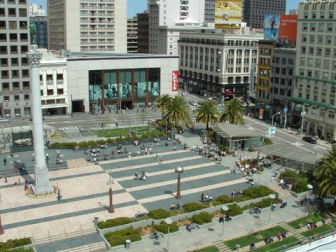 San Francisco’s Union Square is a shopping mecca for luxury items and international goods from around the globe. The history of this area is a fascinating study of politics and economic development in California.
San Francisco’s Union Square is a shopping mecca for luxury items and international goods from around the globe. The history of this area is a fascinating study of politics and economic development in California.
In 1850, John Geary (pronounced Gary) became San Francisco’s first mayor. He sold a one square-block pile of sand to the City for $1 on the condition it would always be a park. Kids began playing a popular new game called baseball here and on other sand lots throughout the City, and so we have the term sandlot baseball.
Prior to the Civil War, southerners dominated California politics. They wanted California to secede from the United States to become an independent republic or join the Confederacy. In 1860, minister Thomas Starr-King came from Boston to head the First Unitarian Church (located where Nieman Marcus is today). He was a spell-binding orator whose speeches on the square urging support for President Lincoln, a Republican legislature and the abolition of slavery drew thousands. The political tide turned. California remained in the Union – thus, Union Square.
By the 1880’s, Union Square was a park of trees, grass and park benches surrounded by a wealthy residential neighborhood of mansions, churches, synagogues, and social clubs.
In 1898, Commodore George Dewey led a Navy squadron to defeat the Spanish Armada in the Battle of Manila, Philippines in the Spanish American War. San Franciscans raised private funds to honor Dewey with the monument in the center of the square. President William McKinley broke ground for the monument in 1901. After McKinley’s assassination, President Theodore Roosevelt dedicated the monument to both Dewey and McKinley in 1903.
At 5:13 a.m. on April 18, 1906, the earth rumbled for 45 seconds like few people had ever felt before. Enrico Caruso, the greatest opera star of the day was at the Palace Hotel and said “Everything in the room was going round and round. The chandelier was trying to touch the ceiling, and the chairs were chasing each other. Crash! Crash! Crash! It was terrible. My God I thought it would never stop. ‘El of a town. I never come back!” He never did.

All around the square was destroyed, with the exception of the St. Francis, which had opened only two years before. It served meals in Union Square to hundreds of earthquake refuges. The St. Francis represented San Francisco in the golden era of hotels through the 1960s, when men wore suits and ties, and women wore hats and gloves in public. It was traditional to say either “Meet me at the St. Francis,” or, “Meet me under the clock.” Everyone knew it was the clock in the St. Francis lobby, where it still stands.
Unwilling to wait until the rubble was removed, wealthy residents of Union Square moved west of Van Ness Avenue. Union Square evolved into a retail shopping district that, like New York, Chicago and Boston, was renowned for its own exclusive merchants, such as the City of Paris and I. Magnin. By the late 1980s, travel, mass media and the homogenization of our culture saw the evolution to the national brands that dominate Union Square today.
This post is written by Peter Moylan – one of San Francisco’s leading walking tour guides and historical authorities. Hear similar stories on Peter’s personal walking, historical San Francisco tours.

No Comments so far ↓
There are no comments yet...Kick things off by filling out the form below.